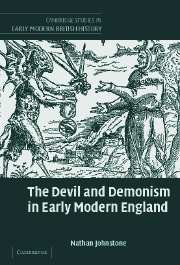Book contents
- Frontmatter
- Contents
- Acknowledgements
- 1 Introduction
- 2 The synagogue of Satan: anti-Catholicism, false doctrine and the construction of contrariety
- 3 Temptation: the Protestant dynamic of diabolic agency and the resurgence of clerical mediation
- 4 Satan and the godly in early modern England
- 5 Incarnate devils: crime narratives, demonisation and audience empathy
- 6 ‘What concord hath Christ with Belial?’: de facto satanism and the temptation of the body politic, 1570–1640
- 7 ‘Grand Pluto's Progress through Great Britaine’: the Civil War and the zenith of satanic politics
- 8 ‘The Devil's Alpha and Omega’: temptation at the cutting edge of faith in the Civil War and the Interregnum
- Conclusion
- Bibliography
- Index
- Cambridge Studies in Early Modern British History
6 - ‘What concord hath Christ with Belial?’: de facto satanism and the temptation of the body politic, 1570–1640
Published online by Cambridge University Press: 23 June 2009
- Frontmatter
- Contents
- Acknowledgements
- 1 Introduction
- 2 The synagogue of Satan: anti-Catholicism, false doctrine and the construction of contrariety
- 3 Temptation: the Protestant dynamic of diabolic agency and the resurgence of clerical mediation
- 4 Satan and the godly in early modern England
- 5 Incarnate devils: crime narratives, demonisation and audience empathy
- 6 ‘What concord hath Christ with Belial?’: de facto satanism and the temptation of the body politic, 1570–1640
- 7 ‘Grand Pluto's Progress through Great Britaine’: the Civil War and the zenith of satanic politics
- 8 ‘The Devil's Alpha and Omega’: temptation at the cutting edge of faith in the Civil War and the Interregnum
- Conclusion
- Bibliography
- Index
- Cambridge Studies in Early Modern British History
Summary
As internal temptation allowed the godly, and the not so godly, to engage with the experience of the demonic subversion of the conscience, so a concept of the temptation of the body politic provided a parallel political analogy which gave a focus to the perception of the subversion of the commonwealth. The final part of this study examines the development of this discourse within England's internal politics, from its definition in Elizabethan conflicts over religious subversion and treason, to the Caroline regime's increasing inability to maintain a theocratic opposition between kingship and diabolism, and ultimately to the reactions to the breakdown of government in the 1640s, in which the perception of diabolism pervaded the polemic of both the royalist and the parliamentarian parties.
It has been argued by a number of historians of the early modern period that the English political nation possessed no language of opposition. Political rhetoric was dominated by an emphasis on consensus, and thus conflict originated in disagreements over the practical operation of the constitution. This picture has been supported by recent work on witchcraft, which has highlighted the way in which an equation between witchcraft and rebellion provided, in Peter Elmer's words, a ‘normative system of discourse which fostered unity and concord in the body politic’. Moreover, this discourse could only survive as an instrument of consensus. Its factionalisation during the Civil War, Dr Elmer argues, entirely destroyed witchcraft's political vitality.
- Type
- Chapter
- Information
- The Devil and Demonism in Early Modern England , pp. 175 - 212Publisher: Cambridge University PressPrint publication year: 2006



